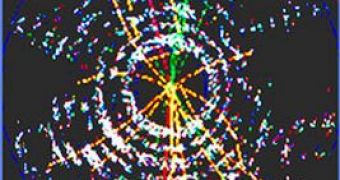A new particle, dubbed particle X, may mediate the rare decay of a Sigma-plus hyperon (a sub-atomic particle) and appears to have close affiliations with a light Higgs boson encountered in one supersymmetric model, a clear proof for physics beyond the standard model (SM).
The researchers from the National Taiwan University, University of La Verne and Iowa State have studied the so-called HyperCP result observed at Fermilab a little over two years ago.
The rare decay of the Sigma-plus hyperon (a strange quark and two up quarks) reveals the possibility of the existence of a new unusual particle.
This particle would behave as the intermediate state when the Sigma-plus decays to its final state, of a proton, muon-plus and muon-minus.
As particle X would present extremely light mass (214.3 MeV), low energy, and smallest-ever branching ratio for a baryon decay, it would be less than a 1% chance of being accounted within the SM.
The breakdown of the SM would mean the start of future investigations in many fields, for many areas unexplained by the SM.
The model named the "next-to-minimal supersymmetric standard model" (NMSSM) that contains seven Higgs bosons, with the lightest one being the main component of a particle called A01, and that A01 satisfies all the constraints of particle X. "If the existence of a very light A01 is confirmed, other models such as the SM, which do not have any light Higgs bosons, will be ruled out," said Jusak Tandean of University La Verne.
"Although the SM has withstood many experimental tests, there are some issues that the model doesn't address. One issue is the so-called hierarchy problem: why the electroweak scale (represented by the W and Z boson masses, of order 100 GeV) is so much smaller than the Planck scale (1019 GeV), at which gravity becomes important for elementary particle interactions," he said.
"One aspect of this issue is that quantum corrections to the Higgs mass make its value arbitrarily large, up to the Planck scale. This clearly contradicts the requirement that the Higgs be lighter than a few hundred GeV. However supersymmetric models (where every SM particle has a corresponding superpartner) can provide a natural solution to this problem", explained Tandean.
"The presence of the superpartners results in the cancellation of the large quantum corrections, leading to a Higgs mass at the desired level. The minimal version of such models is called the Minimal Supersymmetric Standard Model (MSSM). The MSSM is a very attractive model in many ways, but it does not address the question of why the electroweak scale is much smaller than the Planck scale to begin with-this is the so-called mu problem."
"Interestingly, the Next-to-Minimal Supersymmetric Standard Model (NMSSM) solves this problem by adding a set of two particles to the MSSM in such a way that the electroweak scale can be naturally small. The NMSSM has been extensively studied in the literature and has many other interesting features. It is therefore a well-motivated model."
Supersymmetry may reveal some parameters of particle X, where studies on squark and chargino intermediate states in the NMSSM could bring more proof. "The LHC and ILC have the capability of finding the charginos predicted by supersymmetric theories, depending on the chargino masses," said Tandean said.
"In our study, we find that in order to explain the HyperCP results, the lighter chargino mass has to be around 100 GeV, which is within the range to be probed by the new particle accelerators LHC (Large Hadron Collider) and ILC (International Linear Collider). At the LHC and ILC, it is also possible to study the usual Higgs boson, h, in detail. If the A01 is the X particle, the process h --> XX can occur and may become the dominant decay mode if the h mass is relatively small (120 to 130 GeV)", said Tandean.

 14 DAY TRIAL //
14 DAY TRIAL //